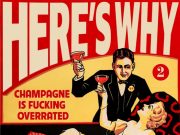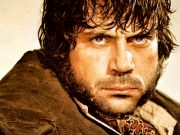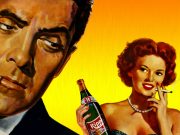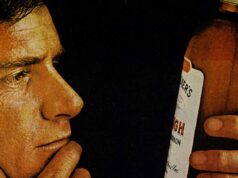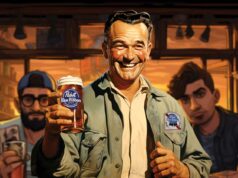Fifteen men on a dead man’s chest—
Yo-ho-ho, and a bottle of rum!
Drink and the devil had done for the rest—
Yo-ho-ho, and a bottle of rum!
—Robert Louis Stevenson, Treasure Island
Pirates.
The word conjures images that have been with us for centuries: a white skull and cross-bones on a flag of black silk; a parrot on the captain’s shoulder; buried treasure; daggers clenched in teeth; walking the plank; eye patches; black-bellied schooners roving free under a Caribbean moon. Pirates were outlaws, carousers and two-fisted warriors, epically lusting after life. They drank with a gusto that was truly magnificent. Their intoxicated exploits are a vital part of our shared Drunkard History. And while they weren’t always pretty, in thought or in deed, pirates were and remain symbolic of our desire to live our lives according to nothing but our personal desires. They lived, killed and died by a very simple ethos: No Quarter Asked, and None Given.
What we understand about pirates, the stereotypical picture in our heads, is a blend of fact and fancy, coming to us in equal parts from literature, the movies, and the reality of their lives.
Daniel Defoe set the stage, from the literary end, with his novels Robinson Crusoe and Captain Singleton, as well as the nominally non-fiction tome The Four Years Voyages of Captain George Roberts, a lengthy account of Roberts’ adventures while a prisoner of the dreaded pirate Edward Low, which is now believed to have been wholly invented by Defoe. Defoe’s descriptions of pirates and life aboard a sailing vessel are surprisingly factual, though he is done one better by Robert Louis Stevenson in his classic novel Treasure Island.
Stevenson shows pirates simultaneously as brutal and romantic. He also provides some of the best-known pirate clichés, right down to the parrot perched on Long John Silver’s shoulder. Stevenson gets it mostly correct as his pirates lust for money, rum, and glory, all while freely indulging their anger and pompous brutality. The pirates plot their strategy while sharing gallons of rum. Before being discovered by young Jim Hawkins, Long John Silver and his dastardly mate, Israel Hands, bring recalcitrant crewmen into their mutiny using the free flow of drink as a persuader.
It’s in the movies, of course, that we get some of our most enduring pirate imagery. Almost always depicted in a romantic light, pirates were often shown as good men fighting villainy through the only means available. A notable example from the early days of film is The Black Pirate starring Errol Flynn. It is remembered chiefly for the jaw-dropping moment where Flynn, under attack and having been chased up into his ship’s rigging, plunges his dagger through a sail and rides the cutting blade down to the deck. And many other movies followed, including five treatments of Treasure Island, culminating most recently with the very fun and well-researched Gore Verbinski movie The Pirates of the Caribbean. In it, the characters of Captain Jack Sparrow (Johnny Depp) and Captain Barbossa (Geoffrey Rush) embody pretty much every pirate stereotype known to western culture. Curiously missing from the movie, though, is drink. About the only time these pirates engage in boozing, they come across more like guys hanging in a sports bar than pirates swilling rye and grog and spitting in the devil’s eye. It’s a sad reflection of our modern culture.
* * *
But who were the real pirates? How long have they been doing their thing? How and where did they live? How were they so successful at engendering fear in the masses for so long?
Pirates have been around for thousands of years. Even before they were called pirates, there were pirates. From the first moment someone decided to transport something valuable by ship, there’s been a pirate or two there to steal it. Ancient history from around the world is rife with tales of pirates harassing innocents on the open ocean, and the oldest tale is nearly five thousand old.
Somewhat more recently, the Scandinavians were the scourge of the seas in the 5th century. They accosted shipping from the North Sea to the coast of Spain, lead by one Alwilda. Alwilda was a woman, which was unusual, but not nearly so unusual as the fact that she seems to have commanded a pirate vessel crewed entirely by women. She might have been counted among the most successful pirates in history had she not fallen in love with her pursuer and one-time betrothed, Prince Alf of Denmark. They married and so ended Alwilda’s career as a pirate.
Like many Scandinavians of the time, Alwilda preferred mead on her ships. Distilled spirits were almost non-existent in those days, but a pirate had to have a way of getting her drunk on. Clean water is very important when sailing the open ocean, but sources were troublesome to locate. Alwilda killed two ‘lubbers with one stone by loading barrels of mead on her ships to quench her crews’ various thirsts.
Sailing off to the Netherlands, a cabal of Dutch pirates called the waterguezen attacked ships and stifled shipping for fifty years in the early 1400s. The Ilanun pirates, mostly of mixed Spanish origin roved from the Philippine coast to Papua New Guinea. The Mediterranean was controlled, literally, for over a hundred years by the famed Barbary corsairs. They used captured slaves to power their boats’ oars, and terrorized coasts from Palestine to Spain. But the men we know as pirates, the ones who comprise our mental pictures, were most active in the Caribbean, the Indian Ocean, and along the North American Atlantic during the reign of King Charles II in the late 1700s. Those guys were pirates, baby.
From hidden coves and inlets in Newfoundland in the north, to hundreds of small islands in the Caribbean, to the bays of Madagascar, classic pirates enjoyed a wide range, and a plethora of secret (and some not-so-secret) bases and hidey-holes.
For several years in the late 1600s the entire island of Madagascar off the coast of South Africa, was controlled by a pair of pirates. Abraham Samuel, who called himself King Samuel, ruled the northern end of the island, while the southern was under the command of James Plantain, the so-called King of Planter’s Bay. Working separately, because the two men hated each other, they preyed upon ships of the British East India Company, and, for all intents and purposes, ran the whole Indian Ocean. The Pirate Kings eventually went to war against each other—over liquor and women. Riches and kingdoms were cool, but don’t go messing with a guy’s liquor or his special lady friend.
Back in the western hemisphere, favorite pirate dens included the Bay of Campeche and the Bay of Honduras in Central America, Tortuga in the Caribbean, Charleston in the Carolina Territory, and New Providence in Nassau, the Bahamas. Hands down, though, the port of call at the top of every pirate’s list was Port Royal, Jamaica. It was the Mecca of piracy, a place where the men could sell their stolen goods and drink up their profits.
Known by pirates and privateers alike as the Port of Orgies, Port Royal was described, at the time, the “most sinful and seditious city in the world.” Surrounded by towering palm trees and fronting waters so blue they begged for Prozac, Port Royal was both the seat of the British colonial government and a 24-hour-a-day frenzy of drinking and debauchery. On no fewer than twelve occasions revelers got going too hard, too fast, and burned their taverns to the ground. Can’t you just see them—dancing, singing, and drinking around the biggest bonfire in town?
One of the characters who prowled the streets of Port Royal was a Dutchman known as Roche Brasiliano. He was an occasional pirate, but mostly a land lubber and the Port’s most notorious drunkard. When feeling festive, Brasiliano would purchase an entire keg of wine and sit on it in the middle of a public walkway suggesting that passersby drink with him. Almost no one refused, since Brasiliano usually made his suggestion by pointing a pistol at his potential drinking partner.
A decent port, a place to call home, was important to pirates (and all other mariners) because life aboard a sailing vessel was far from a picnic. It pretty much sucked, actually, sucked more ass than a pharmaceutical lobbyist. Sailors often went hungry and potable water was tricky to come by, especially on long voyages. It should surprise no one that ships generally packed more wine and rum than water, for the simple reason that liquor guaranteed a cleaner drink. Disease was also a major problem, with the men suffering from scurvy and dropsy (edema), and an entire medical catalogue of lesser ailments. The famous mariner’s beverage, grog (a blend of sugar-water, lime juice and rum), was carried by both navymen and sailors to prevent scurvy. Navy men received grog as their daily rum ration, while pirates drank it as they pleased. Aboard a pirate vessel there was no specific time set aside for hooching; they drank whenever the urge took hold.
In the main, pirates were treated better by their captains than were navy sailors. Surviving records from the High Court of the Admiralty (Britain) are stuffed full of brutal acts dispensed by captains on crewmen. Flogging was an everyday event on British ships for hundreds of years, until a courageous young officer named Winston Churchill ended the revolting practice. And when sailors weren’t being whipped, they were confined in shipboard crawlspaces (“brigs”), lashed to masts to bake in the sun, dangled over the gunwales by their ankles, and deprived of their rum. Records indicate that the road to a mutiny on a British Navy ship wasn’t paved with floggings and danglings, but with the anger of men deprived of their daily tot of rum. Many pirates began their seafaring careers as military sailors, but jumped to pirating to escape the predations of navy commanders. The pay was far better, too. As was the drink.
Not that every pirate captain exemplified warmth and fuzziness. Pirates were an unruly bunch and some captains resorted to extreme punishments to keep order on their ships. Pirates could be cruel to their victims, too, but in many cases these “human sharks” were all dorsal fin and no teeth. They learned early on that things got done quicker when you had a reputation for ruthless brutality. In as many as half the recorded cases of piracy during the golden age of the late 1700s, barely a shot was fired. (The fact is that the two main things victims complained about when interviewed after an altercation with pirates were that the pirates used too many dirty words and smelled too strongly of liquor.) The mere presence of a black sloop gaining on the horizon, Jolly Roger flapping in the wind, was enough to cause your average merchant captain to drop sail and invite them aboard. Striking fear in their victim’s hearts was the whole point for flying black colors in the first place. Some pirates preferred the sneakier tactic of approaching a target flying a friendly flag, but few of these met with high levels of success. No, the really wealthy pirates, the ones with household names even today—Black Bart, Captain Kidd, Blackbeard, etc.—announced their piratical intentions with, as the saying goes, flying colors.
In spite of all the tales of piratical violence, most didn’t want to take lives, they wanted to take goodies. The plunder was the most important thing.
Everyone has heard about pirate treasure; massive iron-banded chests, bulging with gold and jewels, buried in remote locales and found by following hand-drawn maps where “X” marks the spot. While it is true that some pirates accumulated vast hordes of shiny stuff, most true pirate plunder was much more mundane. They went after goods that could be sold for a profit, and stuff they could make use of immediately. As far as goods went, they looked for large amounts of things like cloth, baled cotton, salted meats, and so on. Loot in the more immediate category included almost anything of use aboard the pirates’ ship, such as sails, rope, carpenters’ tools and weapons. Most pirate vessels carried more armaments than the norm, and most of these weapons, from cannon to the pistols used by the men, were stolen from prizes.
When all was said and done, however, the single most popular thing to plunder was liquor. It made the men happy, and had the ability, through its availability or lack thereof, to forestall or cause a mutiny. Check out the following, from the personal journal of the dreaded Edward Teach, better known as Blackbeard:
Such a day; rum all out. Our company somewhat sober; a damned confusion amongst us! Rogues a plotting. Talk of separation. So I looked sharp for a prize [and] took one with a great deal of liquor aboard. So kept the company hot, damned hot, then all things went well again.
Yep. Pirates were drinkers. Whether they bought their hooch in port, swiped it off another ship, or distilled it themselves, they loved their drink, and were some of the grandest revelers of all time. Tales of their debauches are the stuff of myth and legend.
Pirates drank while eating, they drank while sailing, they drank before, during, and after fighting, making them the first great multitaskers. People molested by pirates routinely complained that their oppressors smelled of two things: tar and rum. While rum was the most popular beverage, these guys weren’t picky. You name it, they drank it. Mead, brandy, red wine, and a hysterically awful-sounding homemade concoction of distilled grains and fish oil that I don’t even want to think about.
Since every day aboard a pirate ship was one long happy hour, music, dancing and toasting were the order of the day. Many a buccaneer kept his place in the shipboard hierarchy through his ability to play a fiddle or squeeze box. Impromptu serenades were common, with those who couldn’t play instruments banging away on pots or barrels, and every man singing his throat raw, as they mangled a shanty like only a bunch of drunken sailors could. Throughout the festivities, men offered toasts to their comrades, the captain, their mothers, their captain’s mother, plunder, and the devil, whose praises were hollered above all others. Pirates, perhaps it is needless to say, felt a special affinity for the devil and for deviltry in general.
Sometimes they were forced to go sober for reasons beyond their control, and those were rotten days and nights. At other times they had such a wealth of hooch that they managed to screw up their lives in rather grand fashion. Bleary-eyed pirates beached their ships on sand bars and tore their hulls out on coral reefs. Intoxicated decision-making lead to raids on uninhabited islands and set-tos with larger and better armed military vessels. One gang got loaded on purloined French wine and killed the only guy on board who knew how to use a sextant. They sailed around in circles for days. Another time, the captain of a pirate ship got too deep in his cups and slept though his ship’s capture by the British Navy. He was so shitfaced, in fact, that his captors had to hoist his carcass from the hold with a block and tackle.
In the late 1800s a crew of pirates attacked and looted a ship in the Gulf of Mexico that was bound for New Orleans. As they divvied up their loot they came across a crate containing a beautiful, hand-carved marble fireplace mantel from Italy. They were about to toss it overboard when one of the men read the shipping information and stopped in his tracks. The mantel was on its way to Lynchburg, Tennessee, and the home of none other than Jack Daniel. The pirates had so much respect for Old No. 7 whiskey, that they promptly repacked the mantel and paid to ship it to its rightful owner.
For the ordinary pirate, liquor was mother and father, it gave benediction and exacted penance, it blotted out the heat of the sun and intensified the light of the moon. It sang, it danced, and it sometimes turned pirate itself and gave crappy advice. In heavy weather and mirrored calm, pirates were glorious drunkards, all the way around.
* * *
Almost anyone, if asked, can come up with the name of at least one pirate; they remain that famous today. Way back when they were household names, the mere mention of which caused outbreaks of twitching terror. At the famous-then, not-so-famous-now, end of the scale are men like Edward Low, scourge of the Indian Ocean, and Jean-Bart, a Frenchman who captured 80(!) English ships in a single raid off Dunkirk, and was subsequently knighted by King Louis XIV. There was Bartholomew “Black Bart” Roberts, who amassed greater riches from plunder than any other pirate in history. The French pirate Jean Lafitte, when captured by the American Navy, offered, in return for a pardon from President James Madison, to fight against the British on the American side of the conflicts at the end of the War of 1812. Without his naval skills, New Orleans would’ve been lost to England and the history of our country might have gone quite differently.
Scores of pirates came and went during the classic age of piracy, but history remembers three above all others. They are, Captain William Kidd, Edward Teach, better known as the psychotic Blackbeard, and Captain Henry Morgan. Their lives and exploits are the very definition of the word Pirate. Let’s meet ‘em.
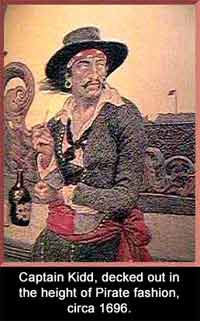 Captain Kidd
Captain Kidd
William Kidd was born in Scotland around 1645, the son of a local landowner. He became fascinated with the sea at a young age and eventually enlisted in the Royal British Navy. Considered an excellent seaman and capable commander, Kidd quickly rose to the rank of captain. He was given his own ship, the Adventure Galley, and unleashed as a privateer for the British crown.
Quickly, the difference between a pirate and a privateer is this: pirates did their thing illegally and without regard to national allegiances, while privateers did the exact same things, but with the approval of their particular government. English privateers, like Kidd, carried a document called a “letter of marque and reprisal” giving them Royal authority to harass the shipping of England’s enemies, whether Spanish or French. It was essentially a license to steal.
Captain Kidd received his letter from Charles II, and set sail for the Indian Ocean to bother the French. But he couldn’t find any. Had he been able to locate even a single French vessel his life might’ve turned out much differently. But after 18 months at sea he hadn’t found so much as a spare beret, and his crew started getting the grumbles. Privateers weren’t given ordinary sailors’ wages, but instead were paid a percentage of their plunder. No prizes meant no money.
Kidd didn’t help this troubling situation by being a bully and a complete jackass. He treated his crew like shit and they hated him. They hated him so much that they once waited for him to go ashore to arrange supplies, and sailed away without him. He caught up with them after a week by commandeering a small sloop. When he demanded to know why they had ditched him, they swore to a man that they had sailed on per Kidd’s own orders.
That Kidd learned nothing from this incident is well documented by the fact that he continued abusing his authority, flogging the men and even denying them their rum. When one crew member complained too strenuously, Kidd beat him to death with a bucket. The rest of the crew was, needless to say, miffed. Sensing a full-blown mutiny, Kidd decided he had better take a ship—any ship—in order to pacify his angry crew.
Within days, he captured two ships, looted them, and burned them each to its water line. That they were merchant vessels belonging to the British East India Company—the very ships he was supposed to be protecting through his privateering—didn’t seem to cause Kidd a great deal of concern. The men got paid, got drunk, and all was well aboard the Adventure Galley for a time.
All was decidedly unwell, however, back in England. Word had reached the Royal Admiralty that Kidd had turned pirate, and he was denounced in Parliament as a traitor. Ships were immediately dispatched to bring him back to England for trial.
When word reached Kidd that he was a wanted man, he hot-sailed it toward his home base in New York City where he had friends in high places. He stopped along the way and instructed his crew to sail into Chesapeake Bay, off Maryland. While the Adventure Galley waited at anchor, Kidd went ashore—alone—in a dory laden with locked sea chests. When he returned several hours later in an empty boat the rumors started flying. Captain Kidd had, so went the whispers, buried his entire horde of gold somewhere on the coast of Chesapeake Bay. He refused all comment, which could only have made stories of hidden loot easier to believe.
Arriving in New York, Kidd sent his crew ashore, their pockets stuffed with coin, while he went immediately to the home of his friend, Lord Bellmont, who was then the governor of New York, Massachusetts and New Hampshire, where he begged the man to save him from the Brits. Bellmont, no friend of England, was more than happy to help—right up to the moment he heard the rumors of Kidd’s buried treasure, at which point he invited Kidd for dinner, got him liquored up, and turned him over to British agents.
Kidd was taken in chains back to England and tossed into the special hell that was Newgate Prison, where he spent the next 11 months. There was much ado over the Kidd situation in Parliament, and Kidd was questioned there several times. He blamed his crew for everything, the weasel. He said that they had mutinied and forced him to attack friendly ships, but the details of his story changed from one telling to the next. Members of his crew, on the other hand, who still hated Kidd to the depths of their salty souls, remained steadfast. In the end, the crew was allowed to go free while Kidd was sentenced to death.
England maintained a special place for the execution of pirates, Execution Dock on the Thames. Kidd was hanged there, and his corpse dangled at the end of the rope for the traditional span of three tides. Afterwards, his body, now gull-pecked and crab-nibbled, was dipped in tar and banded in iron straps, and left to slowly decompose at the mouth of the Thames, a warning to all future pirates of where their destiny would take them if they continued their criminal ways.
Today, at the former site of Execution Dock, there is a pub called Captain Kidd’s. This is ironic because Kidd didn’t particularly care for the booze. This goes a long way toward explaining why his crew hated him so much. He usually allowed his men to indulge, but revoking that right was always his first disciplinary act if they got uppity. It seems apparent that the crew of the Adventure Galley held little trust for Kidd, a sober, mean-spirited, stick-in-the-mud, and when he turned on them, they were quick to hold his feet to the fire. The drinkers went free while the temperate buffoon got his neck stretched. There’s a lesson there someplace. Drink about it.
Captain Edward Teach—Blackbeard
There is no doubt whatsoever that Edward Teach, known the world over as Blackbeard, was one of the most dangerous and unstable men to ever ply the waters in search of plunder and drink. He was crazy as a shit-house rat, stayed drunk night and day, and would sooner kill a fella as say “Ahoy!”
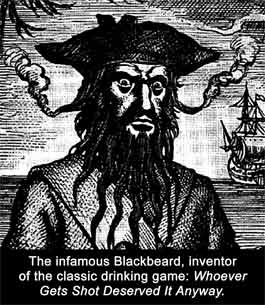 A native of Bristol, England, Teach joined (or “jined” in his colorful parlance) the crew of a pirate vessel at the age of twelve, fleeing English justice for robbery and causing general mayhem. The young hellion impressed his mates with the sheer joy he found in stealing, fighting and drinking. He drank rum by the cask and bought whores three at a time (and would eventually marry fourteen times) all while solidifying his reputation as probably the meanest man alive.
A native of Bristol, England, Teach joined (or “jined” in his colorful parlance) the crew of a pirate vessel at the age of twelve, fleeing English justice for robbery and causing general mayhem. The young hellion impressed his mates with the sheer joy he found in stealing, fighting and drinking. He drank rum by the cask and bought whores three at a time (and would eventually marry fourteen times) all while solidifying his reputation as probably the meanest man alive.
Blackbeard’s favorite territory was along the Atlantic coast, especially Charleston Bay and the islands around Hilton Head. He prowled those shores in his flagship, the Queen Anne’s Revenge, which he had refitted to allow more room for plunder, and mounted additional cannon and swivel guns loaded with grapeshot. He liked to sail with friends aboard, and his wife of the hour, who he often “gave” to a crewman as a reward for excellent service.
Blackbeard was a holy terror in combat. Already prone to dressing in colorful silks and multi-hued scarves, before entering battle he tied ribbons and beads in his beard and extra scarves around his legs and arms. He had a special harness made that he wore on his back. It held six loaded pistols. He carried a cutlass on each hip and a dagger in each boot. To complete his look, he stuck lighted matches in his hair, which glowed with demonic radiance through the holes in his hat. Witnesses say that his eyes, too, glowed red in a fight, glimmering with a hellish bloodthirst.
Blackbeard liked to drink. He liked it a lot. A really, really lot. And when he got good and loaded, he liked to play drinking games. For instance, he would gather his officers for a drinking party in his private cabin, and they would down a cask or two of rum. When everyone was plastered he would put out all the lights, except one candle. He would then instruct the men to duck on his signal, snuff the candle, draw his pistols, and fire at random into the darkened room. If he hit someone, it was proof that the man could not be trusted. The game would go on until someone got shot or Blackbeard got bored. This sort of casts having a few cold ones with the boss after work in a whole other light, doesn’t it?
On another occasion, he and two of his trusted mates drank up a cask of stolen Jamaican rum. Afterwards, Blackbeard grew bored and started looking for entertainment. His eye fell on the his munitions lock-up. “Come,” he bellowed at his comrades, “Let us make a hell of our own and try how long we can bear it.” With that, he sealed the hold and set fire to three pots of brimstone. The game was to see who lasted longest in the smoke. It should come as no surprise that Blackbeard won. He celebrated by letting the crew get as drunk as they pleased. Next time you brag about being the Quarters champ at your frat house, remember the history of your betters.
Eventually, the British colonial government got tired of Blackbeard’s predations. They also got tired of Blackbeard sharing his wealth (to buy protection) with the governor of the Carolinas. The crown told the governor to get a grip on this Blackbeard problem or face the consequences. The governor reluctantly agreed, and asked for a stouthearted volunteer to go out and relieve Blackbeard of his head. Only one man came forward, a twenty-three-year-old lieutenant named Maynard.
The chase lasted months. Blackbeard stayed one step ahead of Maynard, dodging in and out of inlets and islands. One fateful evening, though, Blackbeard anchored and went ashore to get drunk with some local farmers. Maynard spotted the Revenge and waited beyond a curve of land for her captain to return. When Blackbeard returned a great sea battle ensued, with Blackbeard’s ship duking it out with all three of Maynard’s, sinking one and grounding another, before the Revenge high-centered herself on a sand bar. Maynard sailed close and hailed the ship, stating demands for Blackbeard’s immediate surrender. Blackbeard stared across at Maynard, raised a glass of rum, and said, “I’ll give no quarter, nor take none from you.”
Maynard was left with no choice but to attack.
It was recounted later by men who survived the hour-long bout of hand to hand combat that the deck of the Queen Anne’s Revenge ran ankle-deep with blood. Blackbeard’s entire crew was killed, save for one, who was captured trying to set fire to the powder magazine. Blackbeard was the last to go down. By the time Maynard severed his head with two strokes from a cutlass, the pirate was already reeling from many wounds. He’d been sliced and gouged in over a dozen places and shot more than 20 times. Maynard took Blackbeard’s head and hung it from the bowsprit. Folklore has it that, when Blackbeard’s headless corpse was tossed overboard it swam three times around the Revenge before catching a hold of a shark’s fin and riding the great fish down to Davy Jones’ Locker.
Another story that circulated after the dreaded pirate’s demise is that he left a vast horde of treasure buried somewhere along the Carolinas. A cottage industry has grown up in the area devoted to this rumor. So far, treasure hunters have come up with zilch, unless you count the riches gained by local entrepreneurs selling Blackbeard T-shirts to gullible tourists.
Captain Henry Morgan
Think pirate and you probably get an image in your head of Henry Morgan. Why? Because his name and face appears on the label of the second biggest-selling brand of rum in the world. Morgan never made rum. His image was borrowed by Seagram’s as a marketing ploy in the early 1980s. But even though he never made his own rum, Morgan did make a tremendous effort to drink as much of it as humanly possible. On a typical evening he could tip six pints of the stuff and show no exterior effects at all. Morgan’s epic appetite also extended to women and wealth.
 Handsome, genial, and well-educated, Henry Morgan moved with ease through high society (King Charles II was his personal friend), but his first love was the high seas. He was an expert seaman and, unlike his contemporary, Captain Kidd, his crew loved him.
Handsome, genial, and well-educated, Henry Morgan moved with ease through high society (King Charles II was his personal friend), but his first love was the high seas. He was an expert seaman and, unlike his contemporary, Captain Kidd, his crew loved him.
There has always been some question as to whether or not Morgan was a pirate at all. He always carried a letter of marque from the British crown, after all, and confined his attacks to Spanish shipping, striking blows for king and country. On the other hand, his fleet was made up of ships captained by known pirates and he never hesitated to use pirate-style trickery and brutality to achieve his goals. He was also, at age 32, made admiral of a group called the Brethren of the Coast, a loose confederation of pirates and privateers who, sailing the Caribbean, became known as the Buccaneers.
Henry Morgan was born in Wales sometime around 1635. He joined the British navy as a steward and quickly rose through the ranks. As a young officer, he participated in raids against Spanish positions in Hispaniola (Haiti) and Nicaragua, where he distinguished himself and earned a promotion to captain. Soon after, he lead the raid that forever wrested Jamaica from Spanish control. This feat alone would’ve cemented his reputation, but others were to come.
He took the Spanish port, and the fort protecting it, at Portobello, using a fleet of canoes, and accrued zero casualties among his crew. After securing this position, a mainstay for the Spanish defense of Panama, he sent a letter to Don Augusten, governor of Panama, demanding 350,000 pesos (millions of dollars today) or he would attack Panama City and raze it to the ground. Don Augusten relented and gave Morgan his ransom. Morgan and his crew sailed to Port Royal, Jamaica for a hero’s welcome and an eye-popping bacchanalia of drinking and gambling.
A short time later the Spanish broke the peace treaty. In retaliation, England decided to go on the offensive and divest Spain from all its holdings in the West Indies and the New World. The man England picked for the job was Henry Morgan, naming him Admiral of the Fleet of Jamaica, and siccing him on all things Spanish.
The first thing Morgan did as admiral was gather up all his old pirate buddies and plot strategy. Over rum aboard his flagship, the Merchant Jamaica, Morgan and his mates decided that there was only one worthwhile point of attack that would strike the needed blow against Spain: They had to sack Panama City. There would be no hostage-holding like last time around. They would take it and hold it forever, the property of Merry Ol’ England.
Panama had a new governor by this time, one Don Juan, and he wasn’t about to let the hated British set up shop in his town without a fight. He plotted and planned, working on a surprise for the British. When Morgan’s fleet of 38 ships arrived, many flying pirate, not British, colors, Don Juan let them land—and then blew the city to smithereens.
Don Juan had rigged the whole town with barrels of gunpowder, every building, barn, horse trough and tree. On their way out, the remaining members of the Spanish garrison torched one building, which exploded and set fire to the next, and the next, and the next and so on. The chain of explosions lasted over an hour and left a smoking crater where Panama City once stood. Don Juan, his troops, and his charges fled into the hills and jungles, where Morgan’s men lost them. They tried to follow the Spaniards but malaria, starvation, and a lack of liquor stalled the chase almost at once.
Morgan sailed around for a while, looting smaller settlements and ships until he paid off his fleet, then sent them away with his blessings. Morgan himself sailed back to Jamaica, landing to another hero’s welcome. He was promptly knighted by King Charles II and appointed to the post of Lt. Governor of Jamaica.
Henry Morgan settled easily into his new role, though was largely ineffective as a political leader because he was drunk day and night. It’s said that if you wanted Governor Morgan on some matter it was fruitless to go looking for him at his estate. No, you were more likely to find him in one of the many dockside taverns he frequented. He would usually be found whooping it up with a mug of rum in one hand and a comely barmaid in the other, dancing, singing, and generally enjoying a never-ending party at which he was the permanent guest of honor.
People complained about his behavior all the time, the same sort of people who always complain when someone else is having a good time. Morgan was usually able to fend off complaints, however, largely because his prime benefactor, King Charles II, was a well-known hell raiser in his own right. Eventually, though, the voices of propriety won out and Morgan was removed from his post for “irregularities.” A certain brand of Jamaican citizen enjoyed branding Morgan a drunken buffoon, and were glad to have him gone, replaced by a sober doofus who rarely made noise after dark. Before passing judgment on Morgan’s leadership, pause to consider the number of fools and jerk-offs who politicked around the West Indies in those days. All in all, you can make the claim that Morgan was a highly effective leader, in that he did nothing to upset the balance of the island.
After being evicted from his post, Morgan retired to his estate, and the party never stopped. He died in bed on August 25th, 1688. Records indicate that he drank himself to death. He went out the way he lived and never gave an inch.
* * *
So. Pirates. They’ve been part of our international history and folklore for hundreds of years. They are equal parts myth and reality, facts and romance. We like the myth and we like the romance. Those things trump reality every time.
Pirates are so much with us that July 27th is set aside as International Talk Like a Pirate Day. I would like to suggest that we change it to International Drink Like a Pirate Day. We could have some rum, or mix up a batch of ginger beer. If rum won’t get you sayin’ Arrrrgh, Jim lad, then you ought to turn in your eye patch and parrot.
Pirates were sometimes brutal and terrifying. At the same time, they were free people. They lived their lives as they chose. Who amongst us can say the same? And who amongst us has not longed to, like Captain Jack Sparrow, climb behind the wheel of a ship with the wind at our back and sunlight bathing our faces, and said…
“Now . . . pour the rum and show me that horizon.”
(Note: the author is indebted to the works of Charles Ellms, A.J. Baime, David Cordingly, and Charles A. Coulombe.)



